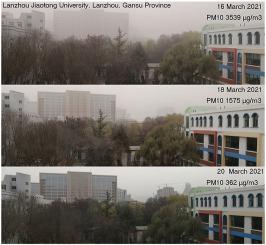Chemosphere ( IF 8.1 ) Pub Date : 2021-09-14 , DOI: 10.1016/j.chemosphere.2021.132219 Mikalai Filonchyk 1

|
A dust storm that formed in the north of China and the southeastern part of Mongolia in March 2021 significantly deteriorated air quality over a large area of East Asia. According to the synoptic pattern, the cause of the dust storm was a cyclone with a significant drop in pressure leading to high winds and dry components of the soil over parts of the Gobi Desert becoming airborne. Data obtained from ground-based air quality monitoring stations show that the observed hourly PM10 concentration greatly exceeded the recommended maximum of 150 μg/m3 with readings above 1500 μg/m3 in the cities of Tianjin, Baoding, Zhengzhou, Luoyang, Zhoukou. In Shijiazhuang, Taiyuan, Jinnan, Xining, Baotou, and Jining. In Handan, it was over 2000 μg/m3. Cities where PM10 concentration exceeded 3900 μg/m3 included Lanzhou, Hohhot, Changzhou, Alashan, Yan'an, Yulin, Hami, Jiuquan, Heze, Hotan, and Baiyin. Concentrations exceeded 7000 μg/m3 on March 15th over parts of the provinces of Inner Mongolia, Hansu and Ningxia, in the cities of Ordos, Jinchang, Wuwei and Zhongwei. According to satellite data, the area of dust covered approximately 450,000 km2. MODIS and TROPOMI data demonstrated high aerosol optical depth (AOD) (more than 1) with a high ultraviolet aerosol index (UVAI) (more than 2), confirming the predominance of dust particles during the storm. Data from CALIPSO show the presence of a dense layer of dust extending from the earth's surface to a height of about 8 km. The Dust Regional Atmospheric Model (BSC-DREAM8b) demonstrates high synchrony with the satellite's surface dust concentration data, ranging from 640 to 1280 μg/m3, and exceeding 2650 μg/m3 in some areas. The purpose of this study is to analyze data from ground-based sensors, satellites, and atmospheric models to better understand the March 2021 dust storm event. The results may be useful for the implementation of protective and preventive measures for both the environment and human health, including air quality control.











































 京公网安备 11010802027423号
京公网安备 11010802027423号